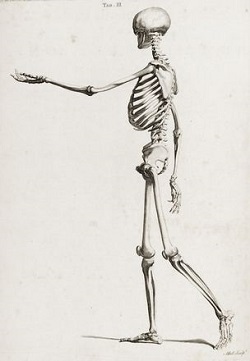A Three-Point Explanation of Alexander Technique
1. The right thing does itself
Like all life on earth, the human body has evolved with gravity ever present. We haven’t simply evolved to cope with gravity, we require it. The force of gravity produces an automatic response which engages our postural muscles. These muscles then hold us up easily, freely and naturally. This is not something we need to consciously manage. Just as our hearts beat and our bodies digest food, being upright should happen without our conscious intervention. The right thing should do itself, and our postural muscles should support us easily, freely, and naturally.
This doesn’t always happen. One major factor in this is…
2. We grow according to what we do
Just as a palm tree will grow into a bent shape when subjected to wind from a constant direction, so we will grow in a distorted shape by constantly putting ourselves in that same distorted position. If slumping becomes a habit, then over time the body will grow in that slumped direction. If neck and shoulder muscles are regularly overtensed, then these muscles will grow as demanded, even if this is beyond their ideal state. The body will try and cope with what is asked of it by growing to accommodate the request. And the more we grow into a distorted shape, the less our postural muscles are able to work for us. We interfere with the right thing being able to do itself. Our bodies can no longer be held up easily, because we have grown into a shape where this isn’t possible.
There may seem a simple solution to this – I will put my body in its best shape and stay there. But how do you know that you are in that shape? You need to rely on your feelings, on how it feels to be in that shape. However…
3. Our feelings are unreliable
Our kinaesthetic sense is the sense of where our body is in space. If you close your eyes and point out the window, it is your kinaesthetic sense on which you rely to guide your arm. Our kinaesthetic sense does not necessarily give us reliable feedback, but is rather more subjective. It is the same as a distorted diet, where a habit of eating excess amounts of sugar will come to feel like a normal requirement. This is especially obvious when it is removed from your diet – even though this is a change for the better, it will probably initially feel worse because you have become used to the feeling of extra sugar, and this has come to feel normal.
Similarly, if you have slumped for many years, this posture will have come to feel normal and straight, even though you can look in a mirror and see otherwise. You have become used to your usual posture, and it has come to feel normal, perhaps even correct. You now cannot rely on the feeling to guide you because the feeling has become unreliable, just as you couldn’t rely on your taste buds to tell you how much sugar to eat after you’ve regularly eaten too much over a long enough period.
So, putting it together

The right thing can do itself if we allow it to – just as we usually see in young children and animals. But, when we start to interfere and distort our natural shape, then we start to grow into a correspondingly distorted posture. The right thing is now less and less able to happen. And we can’t correct this simply by relying on our feelings to tell us whether we’re in the correct shape, because our feelings do not give us accurate and reliable feedback. Rather, they simply tell us whether we’re doing things in the way we’ve become used to, or not.
So what to do?
The Alexander Technique teaches us how to use our bodies in an efficient way, so that we can grow into a posture where the right thing is able to do itself. Over time, we grow into a more opened, lengthened and widened shape. Our postural muscles can function effectively, and our kinaesthetic sense becomes more reliable. The shape we’re in comes to correspond to the shape we feel we’re in. When this happens, it can relieve pain, prevent pain, and give you a more comfortable existence each and every day.